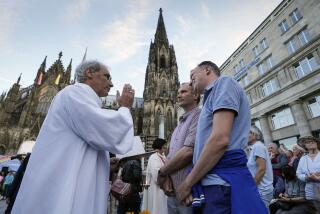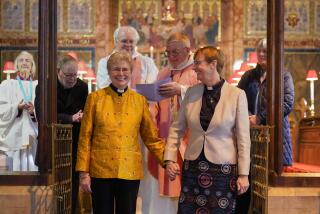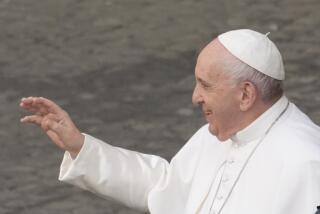Episcopal, Lutheran Accord Heralds New Era of Worship
- Share via
PHILADELPHIA — For nearly a thousand years, ethnic rivalries, theological disputes, battles over church leadership and even murderous hatreds have torn at the soul of Christianity.
But as Christianity’s third millennium approaches, church leaders from Pope John Paul II to national and international Protestant assemblies are poised to usher in a new era far different from the holy wars of old.
Anglican, Orthodox, Protestant and Roman Catholic churches are forging historic agreements of cooperation that could dramatically change how millions worship and see themselves as Christians.
On Friday in Philadelphia, the 2.5-million member Episcopal Church approved a “Concordat of Agreement” with the Evangelical Lutheran Church in America, with 5.2 million members. Lutheran leaders will vote next month on the same measure, which recognizes the validity of each other’s churches, ordained clergy, sacraments and ministries.
Such changes and others to be contemplated in the next several years reach far beyond interdenominational pulpit exchanges and potluck suppers.
The push for Christian unity means that Lutheran congregations could be headed by an Episcopal priest--or Episcopal parishes could be led by a Lutheran minister. Churches could publish common hymnals. Rural churches of different denominations could pool resources and call a common pastor.
In addition, the prohibitions that bar many Christians from receiving the Eucharist, or Holy Communion, in another denomination could, in some cases, tumble like the walls of Jericho.
Certainly, formidable divisions remain among many Christian churches that undoubtedly will spill into the next century, among them differences over the role of women and gays in the church.
But not since the heady days immediately after the Second Vatican Council in the early 1960s, which kindled a blaze of ecumenical activity, has hope burned as brightly for ending--or at least downplaying--divisions among Christians of all denominations.
“Some believe that we’re in the midst of a time when an ecumenical window is open,” said the Rev. Daniell C. Hamby, general secretary of the Consultation on Church Union, a consortium of nine Protestant churches that have been forging an agreement similar to the Episcopal-Lutheran accord. “There is a sense of the moment and the possibilities that now are before us.”
No one is talking about mergers leading to a super church of the kind envisioned 30 years ago during the first blush of the modern ecumenical movement. In most cases, churches are talking about retaining their individual identities and religious culture while acknowledging that they all hold in common the apostolic faith.
The Friday vote in Philadelphia was hailed by Episcopalians and Lutherans alike as an event of historic proportions.
The Rev. J. Robert Wright, a professor of church history and a consultant to the Episcopal Church, called the action “the major ecumenical event for this century, not only for the Episcopal Church but for all churches.”
*
“To me it’s very difficult to control the emotions,” said Lutheran Bishop Ralph Kempski of Indianapolis, who had tears in his eyes after the vote. “I’m very grateful for this day.”
The decision paves the way for pastor exchanges, common parishes and joint ministries and would make permanent an interim agreement allowing Episcopalians and Lutherans to share the Eucharist.
The exchange of clerics between the two churches would begin after Jan. 1, 2001, and joint consecrations of future bishops could begin as early as this fall, if the Lutheran Church also approves the agreement. (The concordat, however, does not include the Lutheran Church, Missouri Synod, a separate Lutheran denomination.)
The vote in the Episcopal House of Deputies, made up of more than 800 priests and members of the laity, came two days after the church’s House of Bishops approved the plan. Only a handful of delegates to the church’s General Convention spoke against the agreement.
Afterward, the Episcopalians began singing “A Mighty Fortress Is Our God,” a Lutheran hymn.
“Today we have the opportunity to make history and make one small step toward once again becoming one Christian church,” said delegate Margaret N. Tinsman of Iowa. “This is the most opportunity we have had since the Reformation.”
Earlier this month, the 1.5-million member United Church of Christ voted to join three other Protestant denominations in sharing congregations and ministers for the first time since the 16th century.
Two of those denominations-- the 2.7-million member Presbyterian Church (USA) and the 400,000-member Reformed Church in America--already have approved the plan. Next up is the Evangelical Lutheran Church, which will vote next month. If the Lutherans go along, the agreement will affect 10 million Protestants in the United States.
Despite recent setbacks, the Vatican continues to hope for a full rapprochement with Eastern Orthodox churches.
Differences between those churches date back to the Great Schism of 1054, which severed ties and led to mutual excommunication. It has only been in the last 25 years that the two churches--which claim 1.2 billion Christians--have begun restoring relations. Talks are continuing, and the pope has said he hopes for some formal reconciliation by 2000.
*
Meanwhile, two groups of churches within Eastern orthodoxy--the Eastern, or Byzantine, churches such as the Greek Orthodox Church, and the Oriental, or so-called nonchalcedonian, churches such as the Armenian Orthodox Church--separated since the year 450 are working toward restoring communion.
At the same time, the searing theological debate between Catholics and Lutherans over the means of eternal salvation--which became a major divide contributing to the Protestant Reformation in the 16th century--is nearing resolution. Last year, a committee of scholars appointed by the two churches agreed to a joint declaration that settled on common language on salvation.
Within the next two years, the 122 churches in the Lutheran World Federation representing 57 million of the world’s 60 million Lutherans will vote on the joint declaration. It also is being reviewed by the Vatican, and Pope John Paul II this month called the declaration “a moment of grace.”
*
Final approval would clear the way for the Lutherans and Catholics to withdraw the mutual condemnations that have been in effect since the 16th century.
In many ways, church leaders are belatedly catching up with the rank-and-file in the pews.
Increasing numbers of Christians have attended other churches and received Communion, despite official prohibitions, since the end of World War II, public opinion polls have shown over the years. Job relocations, intermarriages and the “pick and choose” culture of a consumer society have all affected where people worship--if they worship at all.
Gary King, for one, has grown impatient with the finely nuanced negotiations over theological fine points by his own Lutheran Church and others.
“When you start looking closely at the gradation of differences, it becomes so silly that man has put these rules in place,” said King, who grew up a Methodist and became a Lutheran when he fell in love with the daughter of a Lutheran minister. He is now lay president of the Mt. Olive Lutheran Church in La Crescenta.
“A lot of it has to do with people blowing things out of proportion. I think it’s really important for us to keep focused that it’s one God and we basically have the same beliefs.”
That is what church leaders like Hamby are saying.
*
“In the best of all possible worlds, the dream still exists for many of us of ‘one holy, catholic and apostolic church,” Hamby said. “But I don’t think many of us anymore understands that means a church that is monolithic and uniform, but rather a church that holds the apostolic faith at its center and still maintains its unique gifts and graces.”
Church historians and public opinion polls have found that “brand loyalty” is far less important to many Christians than it seems to be to professional clerics.
“People don’t join churches any more. People join people,” Hamby said. “If a Presbyterian family moves two states away and comes to another town and the Presbyterian church there doesn’t feel like the one they came from but the Methodist or Episcopal church does, then they will join the Methodist or Episcopal church.”
One congregation may even feel more at home with a congregation outside its denomination.
“In a given area, congregations of Episcopalians, Presbyterians and others may find more theological affinity than between two Presbyterian or two Episcopal churches,” said Father David C. Anderson, rector of St. James Episcopal Church in Newport Beach, whose parish is known for its evangelical witness.
“There is so much variation within most of the mainline denominations that you sort of find your theological affinity where you find it,” Anderson said.
Recently, a visit to a Christian chat room on the Internet found a group of Baptists, Catholics, evangelicals and Pentecostals sharing their faith. A comment by one was characteristic. “I’m a Christian first,” she messaged the ad hoc group of America Online ecumenists. “Then a Southern Baptist.”
All this is not to say there aren’t sticky doctrine and church governance issues that remain, not to mention deeply felt personal preferences among worshipers.
*
Church leaders note that some Christians undoubtedly will be troubled by too much change, that many people are comfortable with their church as it is: the familiar hymns, the rhythms of its seasons, the cadence of its liturgies.
To those who have not closely followed ongoing talks, the changes blowing through the church universal may seem sudden. But church leaders say the recent cooperation agreements are built on years of sometimes difficult dialogues and baby steps that began with Vatican II.
“Now after a generation and a half we’ve gotten to a point where we get to make some decisions about what we’ve been talking about,” said the Rev. Randall Lee, an official at the Chicago headquarters of the Evangelical Lutheran Churches in America.
Some leaders speculated that those who see unity as a means of self-preservation may be surprised at the long-term effects.
*
Walter R. Bouman of Trinity Lutheran Seminary in Columbus, Ohio, said that although full communion between Lutherans and Episcopalians will not involve a merger, future generations will get used to the churches having interchangeable clergy and may start questioning why two bishops--one Lutheran and one Episcopalian--are needed for the same territory or diocese.
The road ahead remains uncertain, but a good many Christian leaders think they know where they should be headed.
“I know in my heart that our Lord wants our witness to be in the world and that it would be much more unified,” said the Rt. Rev. Frederick H. Borsch, Episcopal bishop of Los Angeles. “I think that opportunity may be nearer than we think.”
* CHURCH CRACKDOWN
The Episcopal Church moved toward disciplining bishops who won’t ordain women. A23
More to Read
Sign up for Essential California
The most important California stories and recommendations in your inbox every morning.
You may occasionally receive promotional content from the Los Angeles Times.













